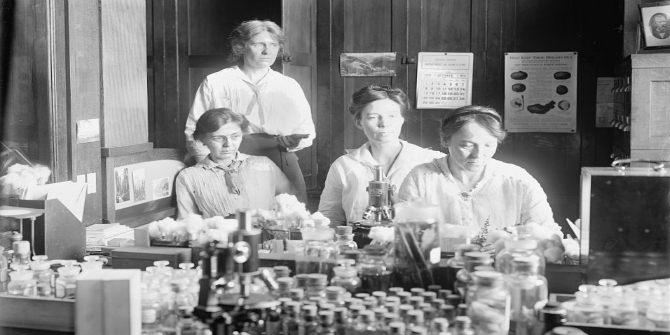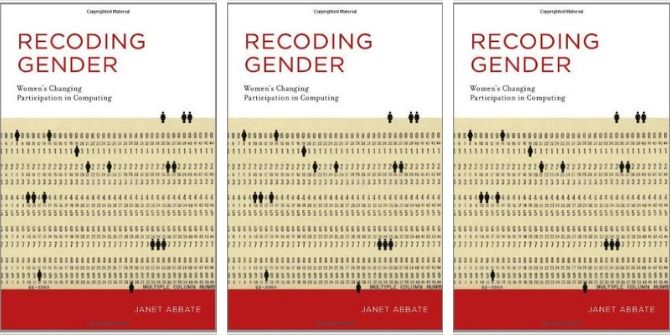 In an era when technology is still associated with masculinity, Girls Coming to Tech! is an important and timely investigation of the gendered history of engineering education in the United States. Amy Sue Bix has done a great job examining the rhetorical traps, social and political obstacles, as well as the widespread hypocrisy around the debates of coeducation in the course of the last century. Although Leonie Maria Tanczer feels conflicted about the title, she encourages engineering students and educators, and scholars of both women’s history and science and technology studies, to read this chronological analysis of women’s struggle to enter this male-dominated territory.
In an era when technology is still associated with masculinity, Girls Coming to Tech! is an important and timely investigation of the gendered history of engineering education in the United States. Amy Sue Bix has done a great job examining the rhetorical traps, social and political obstacles, as well as the widespread hypocrisy around the debates of coeducation in the course of the last century. Although Leonie Maria Tanczer feels conflicted about the title, she encourages engineering students and educators, and scholars of both women’s history and science and technology studies, to read this chronological analysis of women’s struggle to enter this male-dominated territory.
 Girls Coming to Tech! A History of American Engineering Education for Women. Amy Sue Bix. MIT Press. March 2014.
Girls Coming to Tech! A History of American Engineering Education for Women. Amy Sue Bix. MIT Press. March 2014.
Girls Coming to Tech is the second publication in the Engineering Studies Series from MIT Press, the mission of which is to highlight debates about engineering education. It is therefore noteworthy that the gender bias of the field is one of the first aspects to be addressed in this book. Amy Sue Bix, Associate Professor in the Department of History at Iowa State University and Director of the Center for Historical Studies of Technology and Science, reviews the historical data in a comprehensive and accessible way. She covers common excuses as well as methods used to exclude women from the sphere of engineering, and makes a contribution to the continuous battle against gender stereotypes.
The book is broken into seven chapters, split into two parts. The first three chapters cover the overall pre- to post-World War II period. This section provides an examination of engineering education of women across the US. Bix subsequently organises the second part around three university-based case studies, looking closely at Georgia Tech, Caltech, and MIT. The cases emphasise the diversity of reasons which enabled coeducation in the US and offer an exploration of the university-specific post-World War II debate over women’s place in engineering. The concluding seventh chapter brings up current debates, outlining the changing climate up to the present day.
Although the publication starts with examples of female engineers as early as the nineteenth century, the core focus lies on the mid-twentieth century, as key engineering departments started to allow institutional access for women during World War II and throughout the 1960s. Chapter 2 examines how the manpower shortages during wartime transformed not only labour demographics but also the perception of women’s status in engineering. Bix puts an emphasis on Cadette Engineering training such as the Curtiss-Wright recruitment programme, which enabled educational innovations. Under the banner of patriotic imagery, a justification for women’s technical ability was constructed. The notion of a national emergency facilitated a new professional route for women, while this training left a mark on American engineering education.
The most insightful sections of the book, however, are the case studies. Upon closer inspection, these chapters offer more than just investigations of randomly chosen institutions. Instead, they show how the entrance of women to this male-dominated sphere depended on social context, and highlight further the harsh resistance, open willingness, as well as the plain indifference towards coeducation. Chapter 5 explores the California Institute of Technology and is exemplary for the disposition to support coeducation. Despite a rather one-sided tone of voice, the chapter portrays how the masculine identity of Caltech is put into question to tackle rising student dissatisfaction. While Georgia Tech students resisted, undergraduate students of Caltech pressured the faculty board to provide women access to school-intern education. Yet, rather than displaying the undergraduates’ concerns about gender equality, the student body’s support came from their perception of women as possible sexual partners. Stereotypes as well as gender bias were kept alive and make this chapter a particularly fascinating analysis.

Due to the room which is given to individual biographies, the book disproves assumptions about differing male and female preferences and abilities. It is an inspiring resource and yields a balanced ratio of explanations, citations, and illustrations. The inclusion of examples of still-prevailing arguments of those opposing coeducation, such as “not hav[ing] bathroom facilities to accommodate women” (p. 280), as well as the quotes of women on their personal experiences, enrich this publication:
If a women does not choose to date, she is considered strange and/or a prude. If she dates several boys, she is automatically a slut. If she breaks up with someone, […] she is a bitch. If she sticks with one guy only for her entire four years, she is treated fairly. […] She must be clearly someone’s property before she can be related to as a person.’
Overall, the scope of the book is ambitious and broad. It goes into enough depth to make it a good source for students as well as established researchers. The chapters with corresponding sub-headings enable a good flow of reading; however, the multiple universities which are mentioned in the course of the first three chapters leave the reader with a lack of structure. Additionally, the title of the publication is somewhat questionable, as Girls Coming to Tech refers to the headline of the Caltech student paper which welcomed the arrival of potential dates rather than classmates when coeducation was implemented (p. 211). Nonetheless, the use of “girls” instead of “women” is a minimisation of many women’s efforts to enter this male-dominated field and should be questioned.
Ultimately, this book looks likely to provide the historical background for the current efforts to tackle female underrepresentation in engineering. It is necessary to reflect on the gendered dimension of technology and its surrounding “manhood” myth. As Girls Coming to Tech supports this process and gives female engineers a voice and space within this historical analysis, it is a worthy contribution to both the MIT Press’ Engineering Studies Series as well as ongoing emancipatory development.
Note: This review gives the views of the author, and not the position of the LSE Review of Books blog, or of the London School of Economics.
Image Credit: Participants in the Introduce a Girl to Engineering Day, 2012. Credit: Argonne National Laboratory CC BY-NC-SA 2.0.








2 Comments